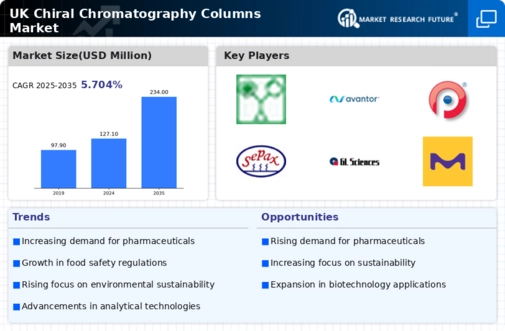The chiral chromatography-columns market is characterized by a competitive landscape that is increasingly shaped by innovation, strategic partnerships, and a focus on sustainability. Key players such as Agilent Technologies (US), Thermo Fisher Scientific (US), and Merck KGaA (DE) are at the forefront, leveraging their technological expertise to enhance product offerings and expand market reach. Agilent Technologies (US) emphasizes innovation in its product development, particularly in the realm of high-performance liquid chromatography (HPLC) systems, which are crucial for chiral separations. Meanwhile, Thermo Fisher Scientific (US) has adopted a strategy of regional expansion, aiming to strengthen its presence in emerging markets while enhancing its digital capabilities to improve customer engagement and operational efficiency. Merck KGaA (DE) appears to focus on sustainability, integrating eco-friendly practices into its manufacturing processes, which resonates well with the growing demand for environmentally responsible products.
The market structure is moderately fragmented, with a mix of established players and emerging companies vying for market share. Key business tactics include localizing manufacturing to reduce costs and optimize supply chains, which is particularly relevant in the context of increasing global trade complexities. The collective influence of these major players shapes the competitive dynamics, as they continuously adapt to market demands and regulatory changes.
In October 2025, Agilent Technologies (US) announced the launch of a new line of chiral chromatography columns designed specifically for pharmaceutical applications. This strategic move is significant as it not only enhances Agilent's product portfolio but also positions the company to capture a larger share of the pharmaceutical market, which is increasingly reliant on chiral separations for drug development and quality control. The introduction of these specialized columns is expected to meet the stringent regulatory requirements in the industry, thereby reinforcing Agilent's competitive edge.
In September 2025, Thermo Fisher Scientific (US) entered into a partnership with a leading biotechnology firm to co-develop advanced chiral separation technologies. This collaboration is indicative of a broader trend towards strategic alliances that leverage complementary strengths. By pooling resources and expertise, both companies aim to accelerate innovation and bring cutting-edge solutions to market more rapidly, which could significantly enhance their competitive positioning.
In August 2025, Merck KGaA (DE) unveiled its commitment to sustainability by launching a new initiative aimed at reducing the environmental impact of its chiral chromatography products. This initiative includes the development of biodegradable materials for column manufacturing and a recycling program for used columns. Such actions not only align with global sustainability goals but also cater to the increasing consumer preference for environmentally friendly products, potentially giving Merck a competitive advantage in a market that is becoming more conscious of ecological impacts.
As of November 2025, the competitive trends in the chiral chromatography-columns market are increasingly defined by digitalization, sustainability, and the integration of artificial intelligence (AI) in product development and customer service. Strategic alliances are becoming more prevalent, as companies recognize the value of collaboration in driving innovation and enhancing market responsiveness. Looking ahead, it is likely that competitive differentiation will evolve from traditional price-based strategies to a focus on technological advancements, sustainable practices, and reliable supply chains, reflecting the changing priorities of consumers and regulatory bodies alike.



















Leave a Comment